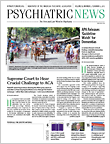Two reports in the American Journal of Psychiatry (AJP) on use of electroconvulsive therapy (ECT) in treatment-resistant mental illness suggest the therapy is effective—though in the case of treatment-resistant bipolar disorder, remission rates using ECT did not differ from rates for patients receiving medication.
In one of the reports, Georgios Petrides, M.D., of Zucker Hillside Hospital in New York and colleagues found that augmentation of clozapine with ECT in clozapine-resistant schizophrenia is a safe and effective treatment option.
They randomized 39 individuals with clozapine-resistant schizophrenia to treatment as usual (clozapine only; N=19) or ECT plus clozapine (N=20). Participants in both groups remained on the clozapine dosage at which they entered the study for eight weeks. Cocurrent use of other antipsychotic medications and antidepressants was allowed, as long as they were taken at a stable dosage for at least 12 weeks before entering the study. Lorazepam, up to 6 mg per day, or diphenhydramine, up to 100 mg, were used as needed for anxiety, agitation, or insomnia.
In the ECT-plus-clozapine group, ECT was administered three times a week for the first four weeks, then twice weekly for the next four weeks. If patients met remission criteria before the completion of eight weeks and showed a plateau in their improvement for two consecutive ratings, ECT was continued weekly through the end of eight weeks.
Petrides and colleagues also included a “crossover phase” in which nonresponders from the clozapine group received an eight-week open trial of ECT.
Response was defined as 40 percent or greater reduction in symptoms based on the Psychotic Symptom Subscale of the Brief Psychiatric Rating Scale and a Clinical Global Impression (CGI) severity rating of less than 3.
The researchers found that 50 percent of the ECT-plus-clozapine patients met the response criteria, while none of the patients in the clozapine group did. In the crossover phase, response was 47 percent. There were no differences between groups on global cognition. Two patients required the postponement of an ECT session because of mild confusion.
“The results of this study suggest that ECT is a safe and effective treatment option for these patients and confirm findings from smaller uncontrolled studies and from earlier case reports,” Petrides and colleagues wrote. “The response rates of 50 percent observed in the randomized arm and 47 percent in the crossover arm compare favorably to all other suggested augmentation strategies for clozapine in this population.”
In comments to Psychiatric News about the study, AJP Editor Robert Freedman, M.D., noted that clozapine helps most patients with schizophrenia that is resistant to other treatment, but still not every patient responds.
“In the first U.S. clozapine study, only 30 percent of patients responded,” he said. “In the recent CATIE study, nearly 20 percent of patients were switched from clozapine for lack of efficacy. Addition of risperidone to clozapine, to increase dopamine antagonism, does not greatly improve response. So the finding by Petrides and colleagues that ECT can improve outcome for 50 percent of this difficult patient group is a valuable addition.”
In a second report appearing in the same issue, ECT was found more effective than an algorithm-based pharmacologic treatment in terms of symptom improvement for treatment-resistant bipolar disorder. At the same time, however, remission rates did not differ between the two groups and remained modest regardless of treatment choice for this challenging clinical condition.
Norwegian researchers randomly assigned 73 bipolar disorder patients with treatment-resistant depression to receive either ECT or pharmacological treatment. ECT included three sessions per week for up to six weeks. The pharmacologic treatment was based on an algorithm published in 2007 by Jamison and Goodwin. Patients who had experienced no effect or intolerable side effects while taking one of the medications listed in the algorithm could be switched to the next treatment option as indicated in the algorithm.
ECT treatment was significantly more effective than pharmacological treatment. The mean scores at the end of the treatment period were lower for the ECT group by 6.6 points on the Montgomery-Åsberg Depression Rating Scale, 9.4 points on the Inventory of Depressive Symptomatology–Clinician-Rated, and 0.7 points on the CGI for Bipolar Disorder.
But the remission rates did not differ significantly between the groups (34.8 percent versus 30.0 percent).
In an editorial accompanying the report, Mauricio Tohen, M.D., Dr.P.H., and Christopher Abbott, M.D., M.S., noted that a possible limitation of the study is whether the patients truly represent treatment resistance; additionally, they said, the duration of each pharmacologic treatment is not provided. “In spite of the above limitations, this report adds major value to the evidence-based data on the use of ECT as a treatment option for bipolar depression,” they said.
They added, “The low remission rate with either treatment highlights the importance of developing better approaches to treatment-resistant bipolar depression.” ■
“Treatment Resistant Bipolar Depression: A Randomized Controlled Trial of Electroconvulsive Therapy Versus Algorithm-Based Pharmacologic Treatment” can be accessed
here. The study had no outside support. “Electroconvulsive Therapy Augmentation in Clozapine-Resistant Schizophrenia: A Prospective, Randomized Study” is available
here. The study was supported by the National Institute of Mental Health.
